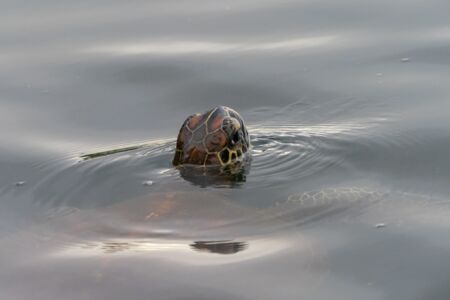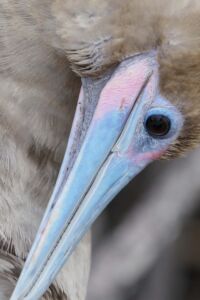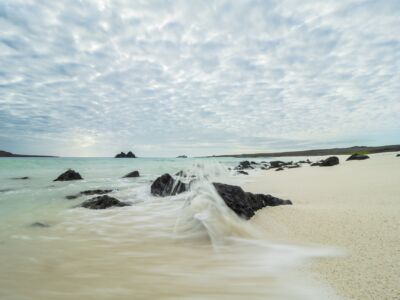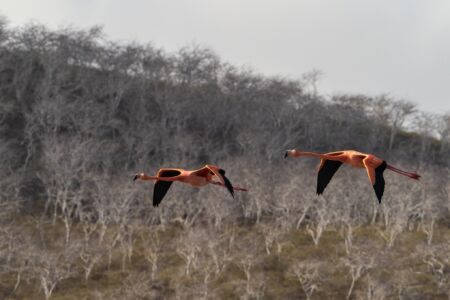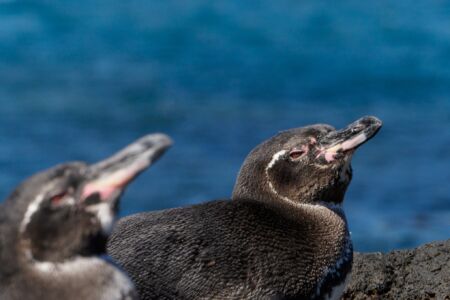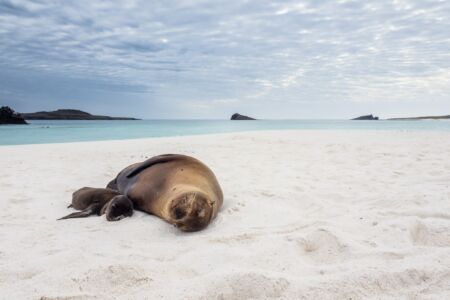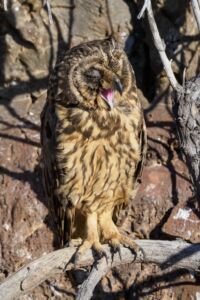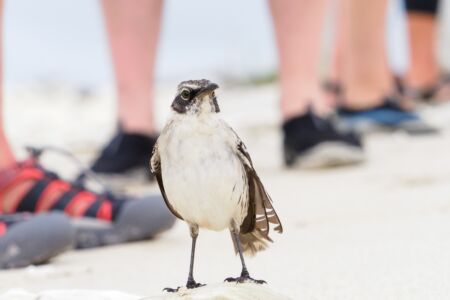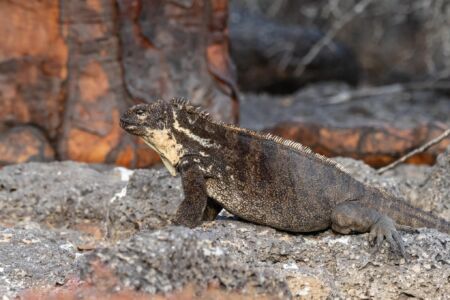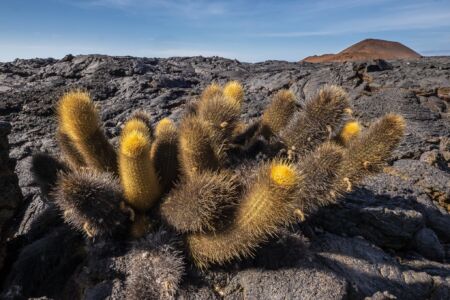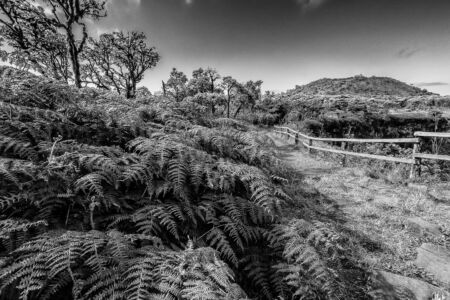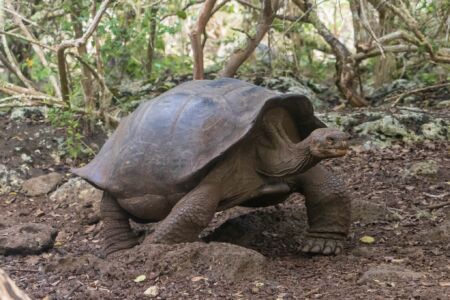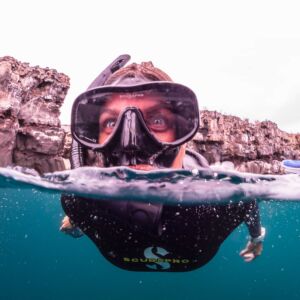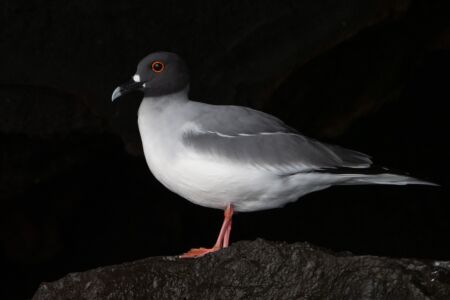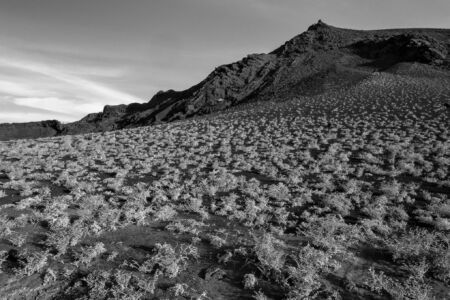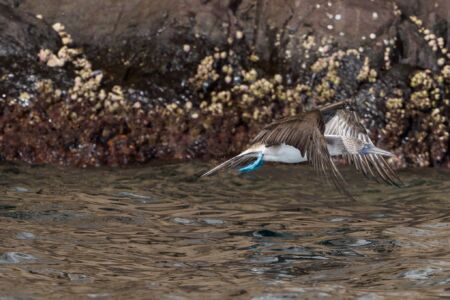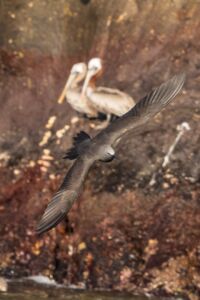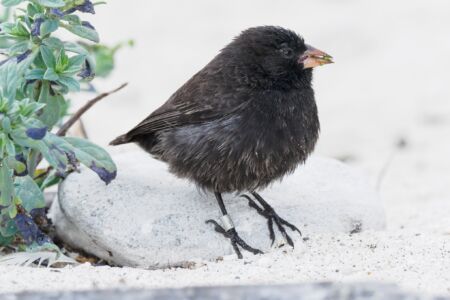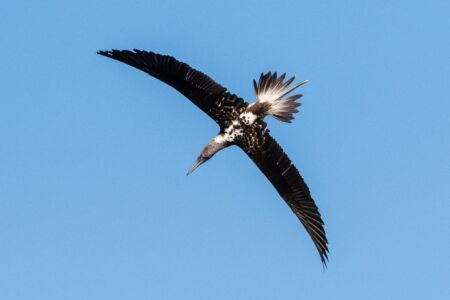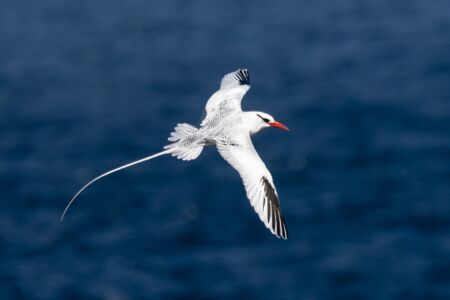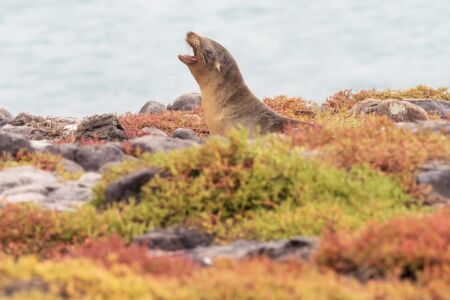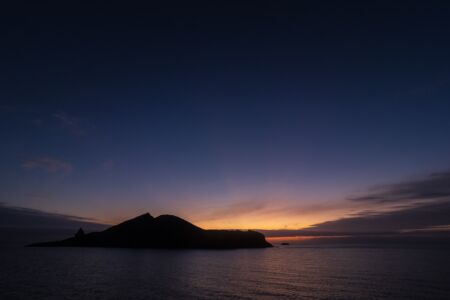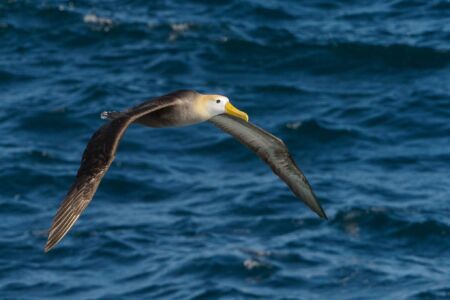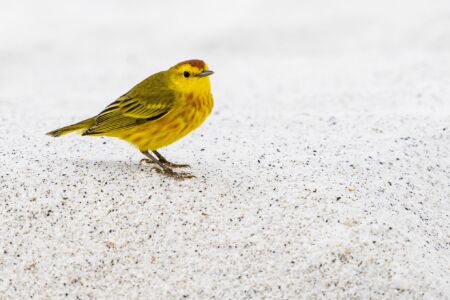TRIP REPORT: GALAPAGOS ISLANDS – 2019 September

TOUR FOCUS
TRIP LEADERS
PRIVATE TOUR OPTION
This tour is available as a private trip for any size group. The tour cost will vary with the number of people and any custom requests.
TESTIMONIALS
Trip report by Lee Hoy
The Galapagos Islands are a photographer and naturalist’s paradise with a plethora of unique and interesting wildlife on every island. The destination beckons the curious and passionate to come and explore beaches, rocky cliffs, open ocean, bays, arid habitat, and forests. Iguanas basking underfoot, boobies waddling along the trail, sea turtles swimming alongside you, frigatebirds soaring overhead, and playful sea lions splashing you in the surf. All this and more were a part of our experience on the September Galapagos Islands trip.
Quito
This was my first Galapagos Islands workshop, which I was privileged to co-lead with Kevin. Upon arrival in Quito, we transferred to the San Jose de Puembo Hotel with the beautiful and bird-filled grounds. This hotel is a special treat with not only unique rooms, but with a restaurant and grounds that just lure you into the beauty of Ecuador. A walk around the grounds found me watching Rufous-collared Sparrows, Sparkling Violetears, Black-tailed Trainbearers, Blue-and-White Swallows, Great Thrushes, Golden Grosbeaks, Rusty Flowerpiercers, and Hooded Siskins – just to name a few. Walking from your room to the restaurant was a beautiful trek through well cared for grounds and spectacular neotropical birds.
Alambi Reserve

White-necked Jacobin (Florisuga mellivora) Adult Male Basic Plumage -Alambi Cloud Forest Preserve – Ecuador – 9 September, 2019 – Lee Hoy
The next morning found us driving over the equator as we headed to Alambi Reserve. This was not our original destination but a landslide had closed the highway upon which the tour would have normally traveled. After a nice drive through many habitats, we finally arrived at the reserve. A short walk to the feeders soon found us immersed in photographing at least 15 species of hummingbirds. While this reserve was not specifically setup for photography, the beauty of the birds nevertheless found us focusing our lenses on White-necked Jacobins, the long billed White-Whiskered Hermit, the very dark Collared Inca whose white collar really stands out among the plumage. Green-crowned Brilliants, Crowned Woodnymphs, and Andean Emeralds also drew our attention. The banana feeders lured in many neotropical birds but my favorite was the almost velvety Crimson-rumped Toucanet. We were able to stay for many hours while other groups came and went in very short stays.
An early evening was necessary so we could get up early and catch our flights for Baltra Island which is the main entry point for the Galapagos Islands National Park. Excitement was running high among our group of photographers and birders. Kevin gave us a presentation each night for the day ahead as this helped prepare us for the birds, animals, plants, reptiles and safety tips to make sure each day was filled with memories that would last a lifetime.
Baltra Island
After our brief flights, we landed and were immediately greeted by some of the Darwin finches hopping around the airport. But we couldn’t get too distracted as we still needed to get to the brand new yacht, the San Jacinto, which would be our home for the remainder of our stay in and around the islands. The boat was very nice with a large seating area/bar which had built-in presentation equipment, a dining area, several decks which were perfect for photographing and viewing wildlife throughout the trip, and our cabins. The cabins were way more spacious than one would have expected and the quality was outstanding. I lacked for nothing during the entire trip. As the tour participants, trip leaders, and boat crew became acquainted while waiting for the boat to get underway, we were already treated to Eliot’s Storm-petrels, Blue-footed Boobies, and Magnificent Frigatebirds flying by the boat.
Santa Cruz Island

Santa Cruz Island – Galapagos Islands National Park – 10 September, 2019 – Lee Hoy
After being restocked and fueled up, the San Jacinto headed toward our afternoon destination which was Santa Cruz Island and the Los Gemelos (Twin Craters) Trail and El Chato Giant Tortoise Reserve. Little did I realize what a wonderful first afternoon it would be. A brief walk around the Los Gemelos Trail led us to two volcanic sinkholes surrounded by tree ferns, bromeliads, a few species of Darwin finches, and lots of mosses. One of the most amazing sights was a very high soaring Galapagos Short-eared Owl, which is very odd behavior for this species. We did wonder if this could be a migrating Short-eared Owl rather than the resident species.
A short drive soon found us at El Chato Giant Tortoise Reserve which is a local ranch where cattle and Santa Cruz Giant Tortoises graze side-by-side. As our small bus traveled down the narrow, unpaved road, we began to excitedly point out the tortoises in the field. Participants rapidly disembarked from the bus and right by the sign for the reserve a medium-sized tortoise was browsing. I laid down on my belly to photograph this tortoise at eye level. The rough shell, the gnarly scales on the legs, the powerful beak, and the elephant-like feet help you realize just how powerful, long-lived and dinosaur-like these reptiles truly are. You feel a strong connection with the past as you realize you are looking at tortoises that may well be over 200 years of age!

Santa Cruz Island Giant Tortoise (Chelonoidis porteri) – El Chato Giant Tortoise Reserve – Galapagos Islands National Park – 10 September, 2019 – Lee Hoy
As we walked the trail, we came to a pond that held White-cheeked Pintail and adjacent to the pond is habitat for Paint-billed Crake and Galapagos Rail. The participants spread out and we searched diligently. Our endeavors were rewarded with great views of the crake, but I struggled to get any decent images. Just another reason to return in the future!
Introduced Smooth-billed Anis, Yellow (Mangrove) Warblers, Green Warbler-Finches, and a Purple Gallinule were also seen and photographed. The sun was beginning to slide toward the horizon and we had to grudgingly leave this beautiful area but not before some of the group were able to see a Woodpecker Finch near the visitor center. Laura, one of the participants, and others decided they wanted to crawl into an empty tortoise shell and have their picture taken. A delicious cheese empanada and it was time to head back to the boat for our first night onboard.
Genovesa Island

Photographers & Birders – Isla Genovesa – Galapagos Islands National Park – 11 September, 2019 – Lee Hoy
While we slept, the captain navigated our yacht to Genovesa Island which was a nine hour trip from our first stop at Santa Cruz Island. One of the best aspects of taking this trip with Wildside Nature Tours is we get on the islands well before any other group and are able to take advantage of the best light and most time on each island we visit. This gives you a much greater chance at seeing all the special wildlife species and have the best light for photography.
We stepped onto the Pangas (zodiac boats) and headed toward the beach at Genovesa that looks out on Great Darwin Bay. As we disembarked, the wildlife spectacle before me was truly overwhelming! Our first steps up the beach revealed basking Galapagos Sea Lions, nesting colonies of frigatebirds, boobies, Lava Gulls lounging on the sand, Genovesa Island Mockingbirds hopping at our feet, Sallly Lightfoot Crabs clambering around on the rocks as the waves broke, resting marine iguanas, and the spectacular Swallow-tailed Gulls which are my new favorite bird! This is truly one of the best spots I have ever been for enjoying and photographing wildlife. And we had it to ourself! Other boats didn’t even bring their groups on the island until we had been there for over two hours.

Nazca Boobies (Sula granti) Adult Basic Plumage – Isla Genovesa – Galapagos Islands National Park – 11 September, 2019 – Lee Hoy
Eventually it was time to return to the boat for some snorkeling and then to head to Prince Philip’s stairs at the other end of the island which is a steep, natural rock staircase that leads to the top of the island where you can explore and enjoy Nazca Boobies nesting among the brush. We hiked to the other side of the island. We eventually came to a very rocky surface and eventually found our first Galapagos Short-eared Owl sitting on the ground as it waited to hunt the storm-petrels flying about. We would eventually find a second owl at a much closer distance. Above the owl, Red-billed Tropicbirds coursed through the air and occasionally would glide to their nesting burrows, Wedge-rumped Storm-Petrels erratic flight style made capturing images a unique challenge, and ugly, downy frigatebird chicks would stare us down with their awkward gaze.
A Small Painted Locust also caught our attention as one of the few species of grasshopper found on any island. On the trek back down the steps, we found a Galapagos Sea Lion who had been injured by a predator, most likely a shark, and we had to cautiously step around him.
South Plaza Island

Isla Plaza Sur (South Plaza Island) – Galapagos Islands National Park – 12 September, 2019 – Lee Hoy
The following morning was grey and overcast as we boarded the pangas for South Plaza Island in hopes of finding one of the rare marine x land iguana hybrids which we promptly found and photographed after a short distance off the pangas. The weather was schizophrenic as it went back and forth from sunny, to overcast to even heavy mist at times. But it didn’t dampen our enthusiasm for the endemic lava lizards, land iguanas, the tree-like opuntia cacti (prickly pear), and the reddish sesuvium (a low growing ground cover that is a beautiful reddish-orange color in the dry season). The loop trail follows along a cliff edge where seabirds kite and whip along the uplifting winds.
Santa Fe Island

Barrington Bay – Isla Santa Fe (Santa Fe Island) – Galapagos Islands National Park – 12 September, 2019 – Lee Hoy
Our afternoon found us exploring Santa Fe Island where we were treated to our first glimpse of the Galapagos Hawk both in flight and perched. One in particular was very focused on a freshly born sea lion pup that still had the umbilical cord attached. The cord would be a very nutritious meal for the hawk but a very protective sea lion mother kept the hawk at bay. A brief walk down the trail and we spotted our first Santa Fe Island Iguana which is a very pretty pale yellowish color. A our local guide, Pedro, soon was quite animated when he found a Galapagos Rice Rat which is only found on Santa Fe Island. Extended views of this species was a real treat for our group and we shared it with another tour company group that came along the trail. A diving Brown Pelican and a migrating Black-necked Stilt on the beach were fun to watch as we eventually boarded the pangas to return to the boat for the night.
Kicker Rock and San Cristobal Island

Roca Leon Dormido (Kicker Rock) Galapagos Islands National Park – 13 September, 2019 – Lee Hoy
The next morning as the sun began to light up the horizon, I could see the outline of Roca Leon Dormido (Kicker Rock) which gets its English name because the formation looks like an upside down boot from one direction and the Spanish name means sleeping lion which is what some believe it looks like when viewed from the south. Some in our group would snorkel around the rock and through the formation, but others would take a panga ride around the edge of the rock to photograph diving Blue-footed Boobies, Brown Noddies, Brown Pelicans, Galapagos Shearwaters, and other birds as they rested on and flew around the rocks. Once the snorkelers and photographers were back on board our ship, the captain immediately began to head toward San Cristobal Island where we would spend the rest of the morning exploring Playa Cerru Brujo. Here I would spend all of my time with my underwater housing and Olympus camera/lens trying to photograph fish, sea lions, sea turtles, and marine invertebrates. Some chose to rest on the beach, some explored the edges of the beach looking for birds, and others, like myself, explored the shallow, rocky wave zones. Galapagos Blennies were entertaining and would often sit within inches of my underwater lens port.
We made our way back aboard and headed to another part of San Cristobal where we landed at Puerto Baquerizo Moreno. One of the few towns on any of the Galapagos Islands. A short bus ride up into the highlands and we were soon hiking in the mist at the Galapagos Islands Center for the Reproduction of Tortoises. The tortoises here are much smaller than some of the other species and the brief hike found us enjoying a Galapagos Flycatcher, the San Cristobal Mockingbird, and more finches. We headed back into town where participants had some time to shop, eat along the boardwalk, and enjoy the wildlife along the docks. Kevin and Laura were temporarily blocked from reboarding the pangas by a large sea lion and Laura’s speed and getting back up the dock was quite impressive!
Espanola Island

Espanola Mockingbird (Mimus macdonaldi) Adult Basic Plumage – Bahia Gardner – Isla Espanola (Espanola Island)
Galapagos Islands National Park – 14 September, 2019 – Lee Hoy
Another night’s rest and we were back on board the pangas preparing for a wet landing and then walking on Espanola Island. One of the neatest experiences are the Hood or Espanola Mockingbirds which are inordinately tame. They will explore backpacks, cameras, and even people and make for a lot of fun in taking wide angle images. I spent a lot of time laying in the sand capturing their images. Resting sea lions and Yellow Warblers walking along the beach also make for nice subjects. A few participants were able to see a whale breech well off-shore. The clouds made for some nice landscape images and we spent some time searching for land hermit crabs, but this is one of the few creatures that eluded us this trip.
The afternoon found us exploring Punta Suarez which is another part of Espanola Island and is one of my favorite spots of all in the islands. As we came onto the beach, there was a large number of marine iguanas lounging along the trail and on the beach. I set my Olympus camera to the pro speed low of 30 frames per second and eventually took some images of the iguanas expelling salt out of their nostrils. We then continued down the trail to the location many of us had been anxiously awaiting.
This island is where the world population of Waved Albatross nest! This massive and beautiful bird treated us to some courtship behaviors even though it was late in the year. We watched them soar along the sea cliffs and I worked hard to capture an image of one soaring with the dark blue waters of the Pacific Ocean behind it. A Galapagos Hawk kited into the wind directly above us and was a very moving experience. We also watched marine iguanas try their best to get back onshore in the rough breakers after foraging in the cold waters. Eventually, we had to move on to another part of the cliff where the Punta Suarez blowhole can be found and as the waves crash onshore, water billows out of the blowhole and droplets travel very far in the wind. This allowed us to take some very nice images of some nesting Blue-footed Boobies that were caught in the mist.
Floreana Island

Dark-billed Cuckoo – Punta Cormorant – Isla Floreana – Galapagos Islands National Park – 15 September, 2019
As I fell asleep that night, I was hoping that the American Flamingoes on Floreana Island would be cooperative the next morning. Well, to say they were cooperative would be the biggest understatement of the trip. Not only were they close, not only did a few flyby at a very close distance, but the males engaged in courtship rituals for quite some time as we lingered by the inland saline lake. All of us were taken aback by our good fortune but eventually we had to cross the island to a beach where some in the group would wade and look for stingrays. On the hike over, we got gripping views and images of a Dark-billed Cuckoo which can be very challenging to see. By mid-morning it was time to reboard the pangas and head to Champion Island where visitors are not allowed to walk on the island but you can motor along the shoreline looking for the Champion Island Mockingbird.
Our boats entered the small cove where the shoreline shared the first Candelabra Cactus of the trip. Patience eventually rewarded us as some of the mockingbirds perched on cacti at the top of the cliff. Some sea lions sparred and some Trumpetfish swam by the boats. We returned to the yacht to head to our afternoon destination, Post Office Bay. This is a location made famous by the post office box where travelers can drop off postcards or mail and wait for other travelers to pick up mail that is destined for locations close to their home. After that, snorkeling was a delight as sea lions would swim up and splash me with their fins. Sea turtles swam right around us and a few stingrays were a challenge to photograph. We concluded the day with a sunset panga ride to view wildlife and watch the sun drop below the waves.
Santiago and Bartolome Islands

Shadows – Isla Santiago – Galapagos Islands National Park – 16 September, 2019 – Lee Hoy

Galapagos Penguin (Spheniscus mendiculus) Adult Basic Plumage -Bartolome Island – Galapagos Islands National Park – 16 September, 2019 – Lee Hoy
I awoke early the following morning and went outside to watch the moon set above Santiago Island. Our morning would be spent exploring the landscape shaped by a relatively recent, 1897, volcanic explosion. We walked over the rope lava and lava bubbles, we found a Large Painted Grasshopper and a beautiful lava lizard. Lava Cactus is one of the first plants to colonize fresh lava and we spent time photographing a fabulous specimen.
The afternoon would be spent in the same area with a panga ride where we got our first real glimpses of Galapagos Penguins as groups swam in the surf and later would roost along the shore. A well-known rock formation on Bartolome Island, Pinnacle Rock, is imposing as you motor alongside it watching penguins and other seabirds. Finally, we headed to the landing on Bartolome Island where a series of 382 wooden steps will take the intrepid traveler to the top of the island with a 360-degree view of the surrounding area. As this was going to be our last night in the Galapagos, Pedro asked me to say a few words about this trip and I obliged. We then took some group photos and a group hug concluded our experience at the top.
Back to Santa Cruz and Baltra, then Quito and home

Black Turtle Cove – Santa Cruz Island – Galapagos Islands National Park – 17 September, 2019 – Lee Hoy
We went back to the yacht for one more night’s rest and then off to explore Black Turtle Cove along the coast of Santa Cruz Island. Here is a great spot to sit in the pangas along a mangrove lagoon and view Spotted Eagle Rays, White-tipped and Black-tipped Sharks, Green Sea Turtles, puffers, and other sea life. The morning passed all too quickly and it was time to head back to Baltra Island to prepare for our flight back to Quito.
The flight back helped me spend time reflecting on the enormity and privilege of the experience. To walk where Darwin walked, to photograph unique wildlife with a wide angle lens, to watch brand new sea lion pups nurse just six feet away, to watch Waved Albatrosses run and glide off the sea cliff, and to hear the splash of Blue-footed Boobies as they plunged into the water mere feet away from the rocks, all of these were just some of the memories that will stay with me until I return to the Galapagos Islands in September 2021. Will you join me again to make new memories?
